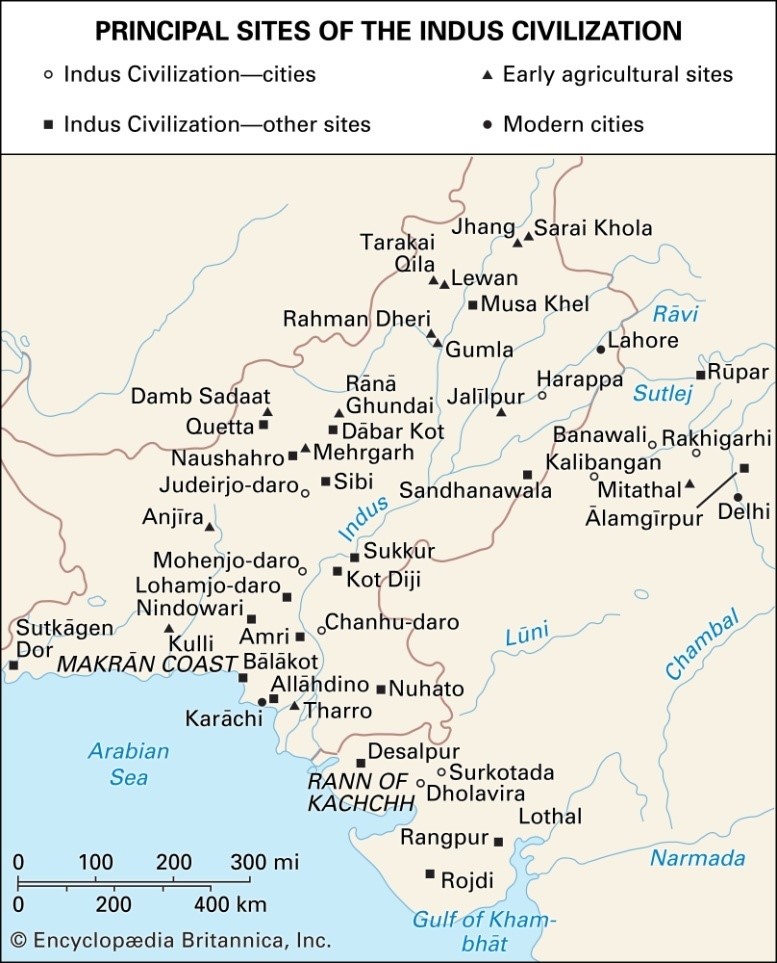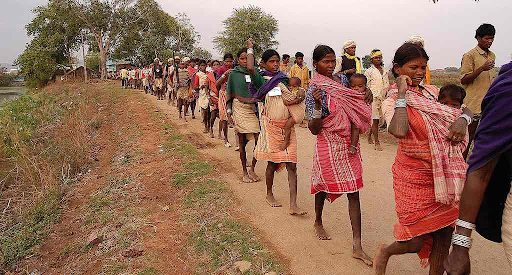Description
Context
- The Prime Minister office has shared an article about the Prime Minister’s vision for the important archaeological sites. Dholavira was accorded UNESCO’s world heritage site status recently.
About
- Dholavira is an example of a proto-historic Bronze Age urban settlement pertaining to the Harappan Civilization.
- It bears evidence of a multi-cultural and stratified society during the 3rd and 2nd millennia BCE.
- It is the first site of the ancient Indus Valley Civilisation (IVC) in India to get the tag.
- Dholavira and the Ramappa Temple were included in the list during the 44th session of the UNESCO’s World Heritage
- Gujarat now has four world heritage sites —
- Dholavira,
- Champaner near Pavagadh,
- Rani ki Vav in Patan and the
- Historic city of Ahmedabad
Distinct features of Dholavira
- After Mohen-jo-Daro, Ganweriwala and Harappa in Pakistan and Rakhigarhi in Haryana of India, Dholavira is the fifth largest metropolis of IVC.
- The site has a fortified citadel, a middle town and a lower town with walls made of sandstone or limestone instead of mud bricks in many other Harappan sites.
- A series of water reservoirs, outer fortification, two multi-purpose grounds, nine gates with unique designs, hemispherical structures like the Buddhist Stupas— as some of the unique features of the Dholavira site.
- Dholavira cites the origin of the Buddhist Stupas.
- Unlike graves at other IVC sites, no mortal remains of humans have been discovered at Dholavira.
- Remains of a copper smelter indicate of Harappans, who lived in Dholavira, knew metallurgy.
- Traders of Dholavira used to source copper ore from present-day Rajasthan and Oman and UAE and export finished products.
- It was also a hub of manufacturing jewellery made of shells and semi-precious stones, like agate and used to export timber.
- Beads peculiar to the Harappan workmanship have been found in the royal graves of Mesopotamia, indicating Dholavira used to trade with the Mesopotamians.
Decline of Dholavira
- Its decline coincided with the collapse of Mesopotamia, indicating the integration of economies.
- Harappans, who were maritime people, lost a huge market, affecting the local mining, manufacturing, marketing and export businesses once Mesopotamia fell.
- From 2000 BC, Dholavira entered a phase of severe aridity due to climate change and rivers like Saraswati drying up.
- Because of a drought-like situation, people started migrating toward the Ganges valley or towards south Gujarat and further beyond in Maharashtra.
- In those times, the Great Rann of Kutch, which surrounds the Khadir island on which Dholavira is located, used to be navigable, but the sea receded gradually and the Rann became a mudflat.

Other Harappan sites in Gujarat
- Lothal, on the bank of Sabarmati river of Ahmedabad district, is another prominent site of IVC in Gujarat.
- It was excavated between 1955 and 1960 and was discovered to be an important port city of the ancient civilisation, with structures made of mud bricks.
- From a graveyard in Lothal, 21 human skeletons were found.
- Foundries for making copperware were also discovered.
- Ornaments made of semi-precious stones, gold etc. were also found from the site.
- Rangpur on the bank of Bhadar river was the first Harappan site in Gujarat to be excavated.
- Rojdi, Prabhas, Lakhabaval in Jamnagar, and Deshalpar in Bhuj are among other Harappan sites in the state.
World Heritage Sites in India
- A World Heritage Site is a landmark or area with legal protection by an international convention administered by the United Nations Educational, Scientific and Cultural Organization (UNESCO).
- World Heritage Sites are designated by UNESCO for having cultural, historical, scientific or other form of significance.
- India has 40 world heritage sites that include 32 Cultural properties, 7 Natural properties and 1 mixed site.
- India has the sixth largest number of sites in the world.
Cultural (32)
- Agra Fort (1983)
- Ajanta Caves (1983)
- Archaeological Site of Nalanda Mahavihara at Nalanda, Bihar (2016)
- Buddhist Monuments at Sanchi (1989)
- Champaner-Pavagadh Archaeological Park (2004)
- Chhatrapati Shivaji Terminus (formerly Victoria Terminus) (2004)
- Churches and Convents of Goa (1986)
- Elephanta Caves (1987)
- Ellora Caves (1983)
- Fatehpur Sikri (1986)
- Great Living Chola Temples (1987,2004)
- Group of Monuments at Hampi (1986)
- Group of Monuments at Mahabalipuram (1984)
- Group of Monuments at Pattadakal (1987)
- Hill Forts of Rajasthan (2013)
- Historic City of Ahmadabad (2017)
- Humayun's Tomb, Delhi (1993)
- Jaipur City, Rajasthan (2019)
- Khajuraho Group of Monuments (1986)
- Mahabodhi Temple Complex at Bodh Gaya (2002)
- Mountain Railways of India (1999,2005,2008)
- Qutb Minar and its Monuments, Delhi (1993)
- Rani-ki-Vav (the Queen’s Stepwell) at Patan, Gujarat (2014)
- Red Fort Complex (2007)
- Rock Shelters of Bhimbetka (2003)
- Sun Temple, Konârak (1984)
- Taj Mahal (1983)
- The Architectural Work of Le Corbusier, an Outstanding Contribution to the Modern Movement (2016)
- The Jantar Mantar, Jaipur (2010)
- Victorian Gothic and Art Deco Ensembles of Mumbai (2018)
- Rudreswara Temple of Telangana (2021)
- Dholavira in Gujarat (2021)
Natural (7)
- Great Himalayan National Park Conservation Area (2014)
- Kaziranga National Park (1985)
- Keoladeo National Park (1985)
- Manas Wildlife Sanctuary (1985)
- Nanda Devi and Valley of Flowers National Parks (1988,2005)
- Sundarbans National Park (1987)
- Western Ghats (2012)
Mixed (1)
- Khangchendzonga National Park (2016)
World Heritage Sites across the world
- The World Heritage List comprises 1121 properties of Outstanding Universal Value.
- Natural sites represent about 23% of this list, including 39 mixed (both cultural and natural) sites and 213 natural sites.
- Apart from India, countries like Italy, Spain, Germany, China and France also have 40 such sites each.
- China is home to largest number of UNESCO world heritage sites in the world. It has 55 world heritage sites.
Benefits of a World Heritage Site designation
- It brings international attention to the need for the preservation and conservation of the site.
- It brings tourism to the site, with its accompanying economic benefits to the host country and local area.
- It can provide funds for restoration, preservation, and training. For example, in 2001, the Taliban destroyed two 6th century, 150-ft. statues of Buddha carved into the mountainside in the Bamiyan Valley in Afghanistan. The site has received more than $4 million from UNESCO to help with reconstruction and to hire a sculptor to re-carve some of the damaged stone.
- It promotes national and local pride in the natural and man-made wonders of the country.
- It promotes close ties with the United Nations system and the prestige and support it provides.
- It provides access to global project management resources.
- It facilitates creating partnerships between government, the private sector, and NGOs to achieve conservation goals.
- Once declared, the site becomes protected under Geneva convention against destruction during a war.
https://pib.gov.in/AllRelease.aspx?MenuId=3














